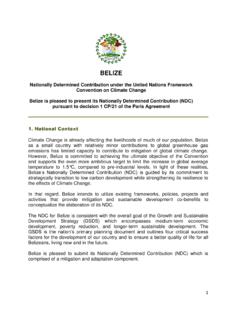Transcription of Peter Jacob Jørgensen, PlanEnergi Biogas - DCA
1 Biogas green .Design .energy suPPly .environmentPeter Jacob J rgensen , PlanEnergiBiogas green energyProcess Design Energy supply Environment Peter Jacob J rgensen , PlanEnergi and Researcher for a Day Faculty of Agricultural Sciences, Aarhus University 20092nd editionEditor: Anna Busch Nielsen & Finn BendixenEnglish translation: Margit SchachtGraphic design: Erik Hj rneFotos: Flemming Nielsen, Agromedia, pages 15, 16, 17 and back pageTorben Sk tt, BioPress, page 18 and front pageEmiliano Bruni, page 20 Sven Halling/Scanpix, page 6 Lehrstuhl f r Thermodynamik, TU M nchen, page 4 Lars Ellegaard, Lemvig Biogas , page 26 Printed by: Digisource Danmark A/SThe material may be reproduced in its entirety. The use of part of the material in other contexts can only take place with the prior permission of the copyright owners.
2 ISBN 978-87-992243-2-1 Researcher for a DayFaculty of Agricultural Sciences, Aarhus UniversityNiels Pedersens All 2, PO Box 10 DK-8830 TjeleT: +45 8999 2511 F: +45 8999 2599 E: is Biogas ? 4 How is Biogas produced? 5 The history of Biogas production 6 Biogas in developing countries 7 The Biogas process 8 Hydrolysis 9 Fermentation acidogenesis 10 Methanogenesis 10 Process parameters for a Biogas plant 11 Inhibition of the Biogas process 12 Biogas plant design 15 Biomass system 16 The gas system 17 End uses of Biogas 18 Gas yield of different biomasses 19 Measuring gas yield 20 Digestion in practice 20 Biogas potentials 23 Current Biogas production and future potential 25 Biogas and the environment 26 Climate change 26 Total CO2 reduction potential with Biogas production 28 Nutrient utilisation and nutrient losses 29 Odour 30 Degradation of pollutants 31 Separation of digested biomass 32 Index 34 Gas
3 % methane (CH4) 55 70 Carbon dioxide (CO2) 30 45 Hydrogen sulphide (H2S)Hydrogen (H2) 1 2 Ammonia (NH3)Carbon monoxide (CO) traceNitrogen (N2) traceOxygen (O2) trace Biogas is a combustible mixture of gases (see figure 1). It consists mainly of meth-ane (CH4) and carbon dioxide (CO2) and is formed from the anaerobic bacterial decom-position of organic compounds, without oxygen. The gases formed are the waste prod-ucts of the respiration of these decomposer microorganisms and the composition of the gases depends on the substance that is being decomposed. If the material consists of mainly carbohydrates, such as glucose and other simple sugars and high-molecular compounds (polymers) such as cellulose and hemicellulose, the methane production is low.
4 However, if the fat content is high, the methane production is likewise high. methane and whatever additional hydro-gen there may be makes up the combustible part of Biogas . methane is a colourless and odourless gas with a boiling point of -162 C and it burns with a blue flame. methane is also the main constituent (77-90%) of natural gas. Chemically, methane belongs to the alkanes and is the simplest possible form of these. At normal temperature and pressure, methane has a density of approximately kg/m3. Due to carbon dioxide being somewhat heavier, Biogas has a slightly higher density of kg/m3. Pure methane has an upper calorific value of MJ/m3, which corresponds to kWh/m3. If Biogas is mixed with 10-20% air, you get explosive air, which as the name indicates is explosive!
5 What is Biogas ?Figure 1. Composition of Biogas . The actual make-up depends on what is being should burn as cleanly as possible. 0 1000 20000 5 10 LakeMarshOcean0 100 200 300 400 Depth, cmDepth, cmDepth, m051015202530400123401234 mol/litre mol/litre mol/litre Figure 2. The Biogas formed at the bottom of bogs and other places with naturally anaerobic conditions can be collected in an upturned bottle with a funnel. The bottle should be filled with water from the start so that the rising methane can replace the water without getting mixed with atmospheric 3. The methane concentration in sediments (the benthic zone) on the floor of marshes, lakes and oceans.
6 The methane concentration is an expression of the quantity of methane -producing bacteria present. How is Biogas ProDuceD? Biogas is produced naturally in swamps, bogs, rice paddies, etc., (see figure 2) and in the sedi-ment at the bottom of lakes and oceans where anaerobic conditions prevail at a certain depth (see figure 3). methane is also created in the rumen of ruminant animals (cows, sheep, deer, camels, lamas, etc.). Heating (calorific) valueThe quantity of heat produced at a complete combustion of a unit of a combustible heating valueThe quantity of heat produced when the fumes are cooled to the extent that the water content (both that of the fuel and the quantity produced in the combustion process) condenses and relea-ses its latent heating valueThe quantity of heat produced when the water in the fuel does not vaporise and release its latent heat.
7 THe History of Biogas ProDuctionPeople have known of the existence of natural-ly produced Biogas since the 17th century and experiments with the construction of actual Biogas systems and plants started as early as the mid 19th century. One of the oldest Biogas systems is the septic tank, which has been used for the treatment of wastewater since the end of the 19th century and is still used for isolated properties where there is no sewerage system. In this type of plant the Biogas is, however, not collected and used. In the 1890s, the Englishman Donald Ca-meron constructed a special septic tank, from which the gas was collected and used for street lighting. In Denmark the construction of bio-gas plants for wastewater treatment started in the 1920s.
8 The gas was initially used to heat the plant s digestor tank and the main purpose was therefore not to extract energy, but to de-compose organic matter in the wastewater and thus reduce and stabilise the sludge, which is a product of the treatment process. In the following period and until shortly after the Second World War, there was a sub-stantial growth in the Biogas industry, particu-larly in Germany, Britain and France, and the Figure 4. Reindeer in the tundra on Svalbard both are active pro-ducers of methane and thus contribute to the greenhouse effect. The reindeer is a ruminant and produces methane in the rumen and the tundra releases met-hane during the sum-mer thaw of the frozen ground. With a warmer climate, progressively more methane will be released, which will contribute to the en-hanced greenhouse effect, thus increasing global warming.
9 And so a vicious circle has started. The impact of methane on the climateHuman activities such as cattle farming, rice farming and the accumulation of waste on large waste disposal sites, etc., are thought to have caused a doubling of the atmospheric concentration of methane to the present level of ppm. This does not, as such, have any effect on human health. However, as methane is part of the chemical processes in the atmos-phere and is also a powerful greenhouse gas (about 22 times as powerful as carbon dioxide, CO2), the gas is a contributor to the greenhouse effect. methane has thus contributed about 20% to the total increase in the greenhouse ef-fect caused by human activities. If the greenhouse effect results in an increa-sing temperature rise on our planet, there is a risk that the large areas of tundra currently under permafrost will slowly thaw, which will result in the release of huge quantities of methane when organic materials are gradually decomposed.
10 This will obviously further exa-cerbate the greenhouse effect (see figure 4). methane in large quantities also destroys ozone. Rising methane emissions can therefore have unfortunate consequences for the ozone layer that helps protect the Earth against the harmful ultraviolet radiation from the sun. Number Biogas production in Denmark in 2006 1,000 m3 Municipal sewage treatment plants 61 ~ 40,000 Communal Biogas plants 19 ~ 73,000 Farm Biogas plants 57 ~ 33,000 Landfill gas plants 25 ~ 18,000 Industrial plants 5 ~ 7,000 Total 167 ~ 171,000 Total Biogas production in Denmark is 4 PJ, which is about 5 of the total energy manurePlant residuesFoodBiogas for cookingMulberry tree with silkwormsFertiliserSludge (fertiliser)Fish pondBiogas plant technology also gradually found its way into agriculture with energy production as the main purpose.





